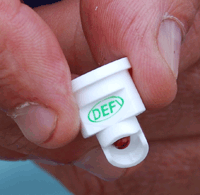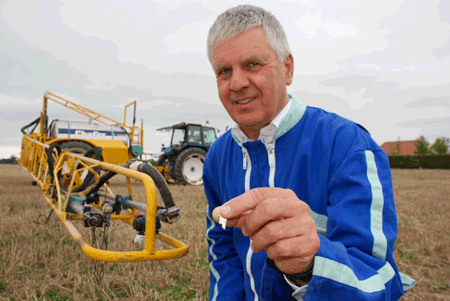Pre-em nozzle improves efficacy

A new sprayer nozzle designed specifically to work with pre-emergence herbicides has been launched by Syngenta.
Nozzle choice is well known to have an impact on the performance of foliar-applied crop protection pesticides, but less is known about how different nozzles affect pre-emergence herbicides, where the target is the soil surface.
But trials by Syngenta have shown blackgrass control with pre-emergence herbicide Defy can be improved by up to 25% using alternative nozzles to the traditional 110° fan jet.
The findings led Syngenta’s application specialist Tom Robinson to develop a specific nozzle for use with pre-emergence herbicides. As well as maximising efficacy it works at a range of speeds, minimises drift and remains effective at higher boom heights.

Efficacy is improved because the herbicide is spread evenly over the soil surface and shadowing effects of clods in the seed-bed are removed.
Angling the jet so it makes contact with the side of the clod as well as the top gives greater coverage than a standard vertical nozzle, which only strikes the top of the object. (See pictures)
The boom is set so that alternate nozzles are forward-facing, to cover the front side of the clod, and backward-facing to spray the rear side, removing the shadowing effect, Mr Robinson says.
Pre-emergence applications are also at greater risk of drifting, he says. Not least because of advances in sprayer technology over the past five years such as increased boom width. Some sprayers, unfortunately, are unable to get the boom down to 0.5m above the ground, he notes.
“To quote Paul Miller (TAG): ‘If wind speed doubles, drift doubles, but if boom height is doubled drift increases by a factor of 10.”
While less important when spraying standing crops, it does contribute to drift during pre-emergence applications, he explains.
In addition, active suspension has allowed speeds to increase from 12 to 16km/h, contributing to drift, he adds.
The Defy nozzle compensates for these changes by optimising the inclination angle of the nozzle and the droplet size, giving greater deposition and reduced drift, says Mr Robinson.
Wind tunnel tests at Silsoe Spray Application Unit showed that at 0.5m boom height, the Defy nozzle gave deposition at least as great as Syngenta’s Hawk nozzle. When the boom was raised to 0.75m, the benefit of the Defy nozzle persisted, but deposition was slightly reduced.
In addition, drift was half that of a standard flat fan nozzle at both boom heights in 2m/sec winds.
The tests show the nozzle is effective up to speeds of 17km/h and can be used at 0.7m, although the optimum speed is 14km/h and the optimum boom height is 0.5m.
It is available in 03, 035 and 04 sizes which equates to 12, 14, and 16km/h. “100 litre/ha is my preferred application,” he says. Operating pressure ranges from 1.5-3.0 bar, with the optimum of 2.0-2.5 bar.
By rotating all nozzles to be forward-facing it is also effective as a post-emergence nozzle, he says “It will remain effective as long as there is some soil showing and it may be effective even later; we need to do more testing to find out how long.”
Importance of pre-emergence applications
High blackgrass dormancy and the potential for much earlier drilling, means pre-emergence applications will be even more important this year, says Syngenta’s Simon Parker.
Early drilling leads to increased blackgrass competition, more heads per plant and increased seed return, he says. “Taking out the competitiveness of blackgrass early on will be essential.”
Using pre-emergence herbicide mixes will also be increasingly important, he adds. “It will be important to introduce different modes of action to minimise resistance risk.”
Establishing crops correctly in a firm, fine seed-bed could improve the efficacy of pre-emergence herbicides, he says. “Choosing a competitive variety and seed rate is also important for maximum competition.”
Defy nozzle specification and recommendations
- Fan angle – 83° at 40° inclination
- Sizes available – 03, 035 and 04
- Operating speed – 12-16km/h
- Optimum speed – 14km/h
- Optimum boom height – 0.5m
- Can be used at 0.7m boom height
- Operating pressure – 1.5-3.0 bar
- Optimum pressure – 2.0-2.5 bar
- RRP – £5 per nozzle

